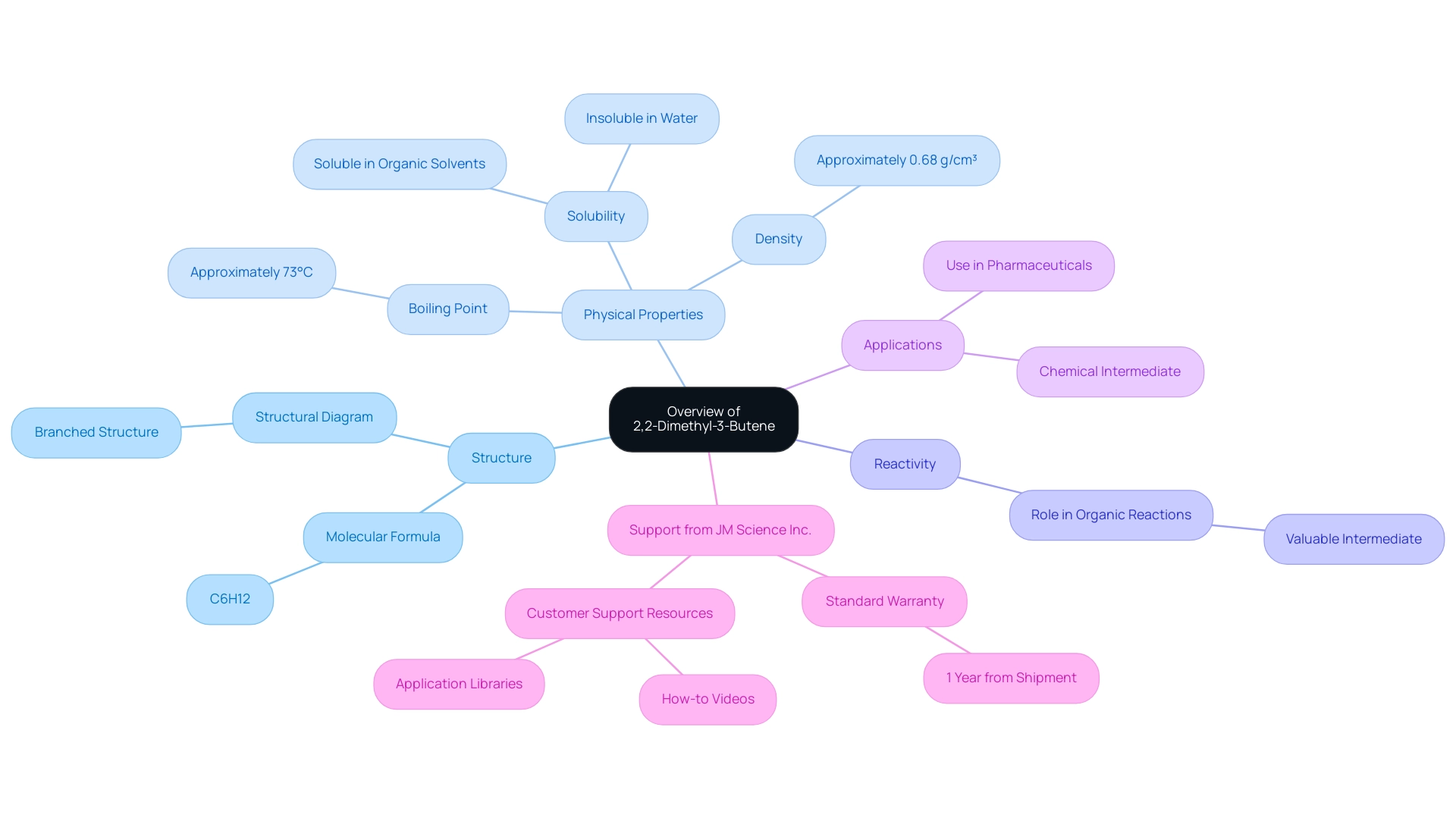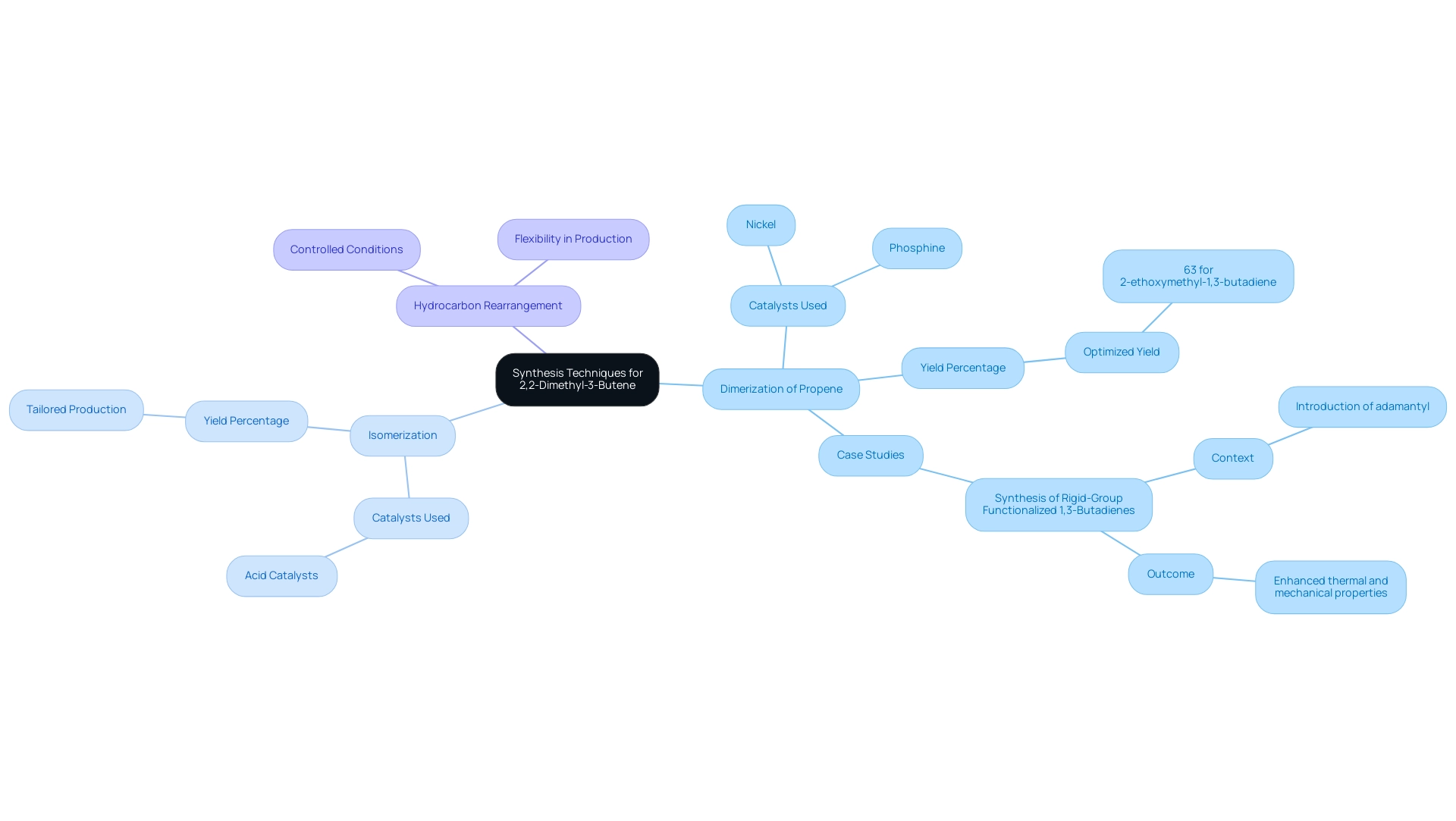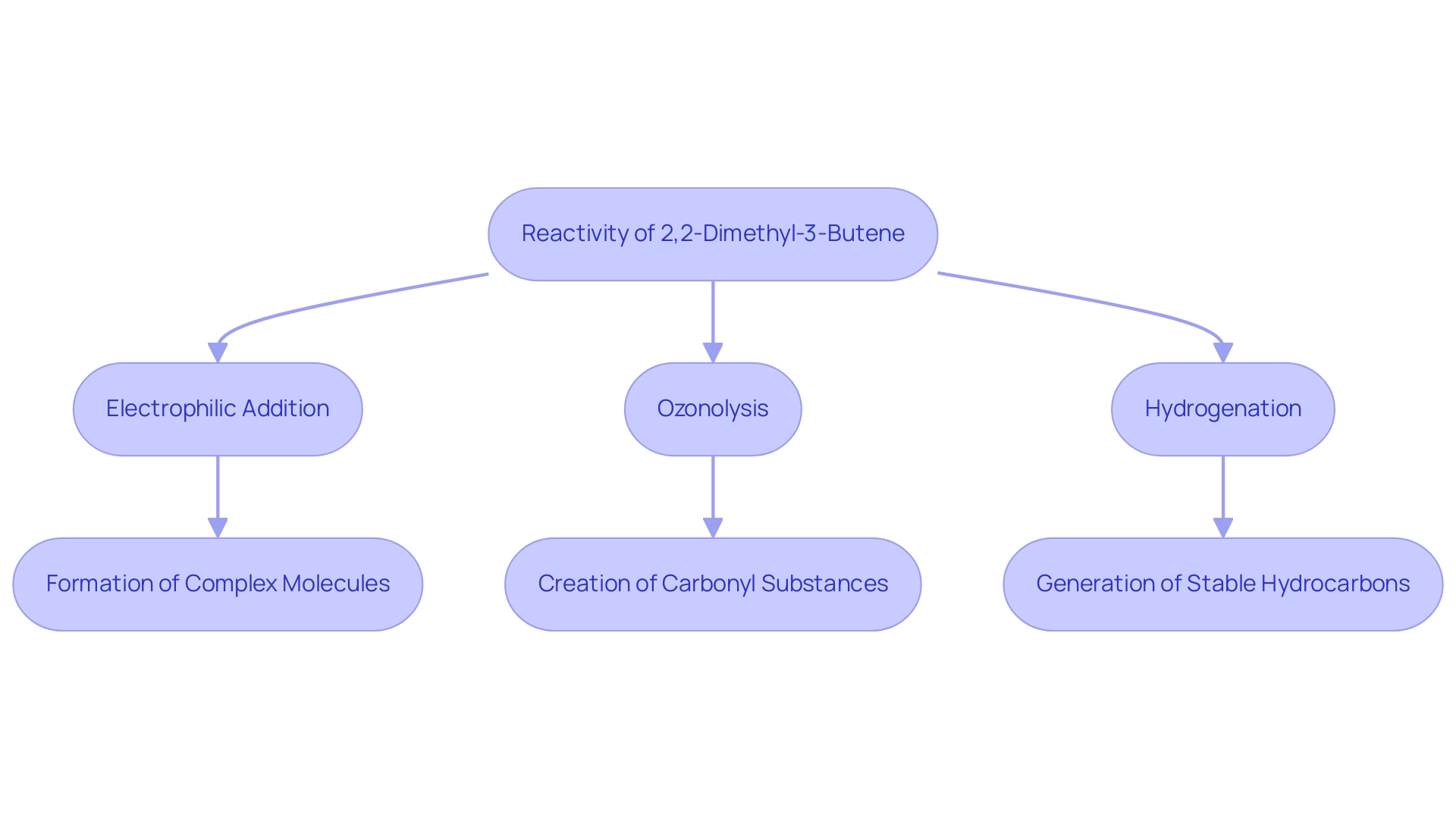Overview
2,2-Dimethyl-3-Butene is a branched organic compound characterized by the molecular formula C6H12. Its reactivity and versatility render it significant in various chemical processes, particularly in the synthesis of pharmaceuticals and plastics. This article underscores the importance of 2,2-Dimethyl-3-Butene by detailing its:
- Structural properties
- Synthesis methods
- Applications across industries
It emphasizes the compound's role as a valuable intermediate in organic chemistry and highlights the growing demand for its use in sustainable production practices. Understanding the multifaceted nature of this compound is essential for leveraging its potential in innovative chemical applications.
Introduction
In the realm of organic chemistry, 2,2-Dimethyl-3-Butene emerges as a compound of considerable significance, characterized by a unique structure and a range of properties that render it invaluable across various scientific applications. With its molecular formula C6H12, this colorless liquid is recognized not only for its reactivity, attributed to the presence of a double bond, but also for its essential role as an intermediate in the synthesis of complex organic molecules.
As industries increasingly pursue innovative solutions in chemical manufacturing, pharmaceuticals, and sustainable practices, a thorough understanding of 2,2-Dimethyl-3-Butene—encompassing its synthesis techniques and safety considerations—becomes paramount. This exploration not only highlights the compound's utility but also underscores the evolving landscape of research and application surrounding it, paving the way for future advancements in organic synthesis and industrial chemistry.
Overview of 2,2-Dimethyl-3-Butene: Structure and Properties
An organic substance characterized by the molecular formula C6H12 showcases a branched structure, featuring two methyl groups attached to the second carbon of a butene chain. This compound exists as a colorless liquid at room temperature, with a boiling point of approximately 73°C, thereby proving its versatility in various organic processes. Its structural representation is as follows:
CH3
|
CH3-C=CH-CH3
|
CH3
The presence of a double bond within its structure significantly contributes to its reactivity, positioning 2,2-Dimethyl-3-Butene as a valuable intermediate in numerous chemical reactions. Recent research underscores its utility in the synthesis of complex organic molecules, showcasing its pivotal role in advancing organic chemistry. Furthermore, studies indicate that the unique properties of this substance, such as its boiling point and reactivity, render it an essential component in the development of pharmaceuticals and other chemical products.
In terms of physical properties, this compound exhibits a density of approximately 0.68 g/cm³, which is lower than that of water. It is insoluble in water but soluble in organic solvents, enhancing its applicability in various laboratory settings, particularly in reactions requiring non-polar solvents.
JM Science Inc., a prominent distributor of scientific instruments, emphasizes quality and reliability in its offerings. The company provides a standard warranty of 1 year from the date of shipment for products without retest or expiration dates, reflecting its unwavering commitment to customer satisfaction. As stated by Technical Support, "For products without retest or expiration dates, our standard warranty of 1 year from the date of shipment is applicable."
This assurance of quality is crucial for laboratories utilizing substances like this compound in their research and applications. Moreover, JM Science Inc. supports its customers with extensive resources, including how-to videos and application libraries, which can aid in the effective utilization of products in laboratory settings. This commitment to customer support enhances the significance of this compound in practical applications across multiple scientific fields.
Overall, the structure and properties of 2,2-Dimethyl-3-Butene not only underscore its significance in organic chemistry but also reflect its potential in practical applications, particularly in the evolving landscape of laboratory practices supported by companies like JM Science Inc.

Synthesis Techniques for 2,2-Dimethyl-3-Butene
The creation of a specific organic compound is achievable through various methods, each offering distinct benefits based on the desired yield and purity. Key methods include:
- Dimerization of Propene: This widely utilized method employs catalysts such as nickel or phosphine to facilitate the dimerization of propene, resulting in the formation of a specific dimethyl butene. Recent advancements in catalyst efficiency have led to improved yields, making this approach increasingly attractive for industrial applications. Notably, reports indicate yields exceeding 60% under optimized conditions, with a specific yield of 63% for 2-ethoxymethyl-1,3-butadiene obtained after distillation under reduced pressure.
- Isomerization: Beginning with 2,3-Dimethyl-1-Butene, isomerization can be effectively executed using acid catalysts. This method enables the transformation of the starting material into 2,2-dimethyl-3-butene, providing a viable pathway for production that can be tailored to specific needs.
- Hydrocarbon Rearrangement: This technique involves the rearrangement of hydrocarbons under controlled conditions to yield the desired substance. The flexibility of this method allows for adjustments in reaction parameters to enhance the production process.
Each of these methods has been explored in various case studies, underscoring their practical applications and efficiencies. For instance, the case study titled "Synthesis of Rigid-Group Functionalized 1,3-Butadienes" illustrates the incorporation of adamantyl into 1,3-dienes, showcasing the stability and properties of the synthesized compounds, which can enhance the thermal and mechanical properties of polymers.
Moreover, expert insights from Hui-Teng Er indicate that the carbenes were captured with various reagents, highlighting the complexity and versatility of preparation techniques. The selection of catalyst plays a crucial role in determining the overall success of the process, with ongoing research focused on developing more effective catalytic systems.
In summary, the creation of this compound involves a range of techniques, each with its own set of advantages. JM Science Inc. is committed to updating its product offerings and maintaining strong relationships with top manufacturers, ensuring that researchers and industrial chemists have access to the latest developments and methodologies in this area.

Chemical Reactions and Reactivity of 2,2-Dimethyl-3-Butene
2,2-Dimethyl-3-Butene is a significant compound in organic chemistry, renowned for its involvement in several key chemical reactions. Its double bond readily engages in electrophilic additions, facilitating the formation of more complex molecules. This reaction is essential in synthesizing various organic substances, showcasing the material's versatility in organic synthesis.
Moreover, ozonolysis plays a critical role in this compound's reactivity. This reaction involves the cleavage of the double bond with ozone, leading to the creation of carbonyl substances. Ozonolysis is particularly valuable in synthetic pathways, allowing chemists to create functionalized products that are essential in pharmaceuticals and other applications.
Additionally, hydrogenation transforms the double bond in a specific alkene into a saturated hydrocarbon under conditions involving hydrogen gas and a catalyst. This process is vital for generating stable substances that can be utilized in various chemical applications.
Recent studies have highlighted the reactivity of 2,2-Dimethyl-3-Butene, particularly in electrophilic addition reactions, where it demonstrates a notable propensity to engage with various electrophiles. For instance, the addition of C1-C4 alkanes significantly influences heat release and pressure peaks in reactions, delaying their occurrence and affecting overall reaction kinetics. This insight is crucial for understanding the dynamics of reactions involving this specific compound.
Furthermore, the production rate of OH radicals for pure DME peaks at temperatures of 650 and 800 K, providing valuable insight into the reactivity of this compound concerning radical formation and its effects in various processes.
In practical applications, ozonolysis of certain alkenes has been employed to synthesize valuable intermediates in pharmaceutical production, illustrating its importance in real-world chemical processes. The substance's reactivity and the results of its reactions underscore its significance in organic creation, establishing it as a central focus for ongoing research and development in this area. As highlighted by Tamás Turányi, "This study employs a novel concept for addressing kinetic optimization for large-size mechanisms," underscoring the importance of kinetic factors in the reactions of this specific alkene.
Moreover, the commitment to quality and customer support by companies like JM Science ensures that high-quality reagents and instruments are readily available for these reactions, enhancing the reliability and efficiency of the processes involved.

Applications of 2,2-Dimethyl-3-Butene in Industry
2,2-Dimethyl-3-Butene is a versatile compound with significant applications across multiple industries, including:
- Chemical Manufacturing: This compound serves as a crucial intermediate in the synthesis of various chemicals, notably in the production of plastics and synthetic rubber. Its role in these processes is vital, contributing to the development of materials essential in everyday products. The 2,3-butanediol sector, closely connected to this compound, is expected to expand at a CAGR of 3.5% from 2023 to 2031, signifying a rising demand for this compound in manufacturing.
- Pharmaceuticals: In the pharmaceutical sector, 2,2-Dimethyl-3-Butene is integral to synthesizing various pharmaceutical agents. Its unique chemical properties facilitate the development of innovative drugs, playing a pivotal role in advancing drug discovery and development processes. Recent trends in the industry emphasize the substance's increasing significance, especially as the pharmaceutical sector continues to grow.
- Fuel Additives: The characteristics of this compound make it suitable for use as a fuel additive, enhancing performance and efficiency in combustion engines. This application is increasingly relevant as industries seek to improve fuel efficiency and reduce emissions, aligning with global sustainability goals. Notably, an estimated 180 million metric tons of artificial fertilizer is utilized to produce about 40% of the world's food, showcasing its relevance in sustainable practices.
The market demand for 2,2-Dimethyl-3-Butene in pharmaceuticals is on the rise, driven by the continuous growth of the pharmaceutical sector and the necessity for effective synthesis techniques. As the industry evolves, the substance's role is expected to grow, particularly in the context of developing new therapeutic agents. Furthermore, the latest trends in chemical manufacturing highlight a shift towards more sustainable practices, with this compound recognized for its potential in green chemistry initiatives.
Recent case studies illustrate the compound's industrial applications, showcasing its effectiveness in various synthesis pathways. For instance, the Dimethylformamide market is anticipated to expand from 3.0 USD Billion in 2023 to 4.5 USD Billion by 2032, reflecting the economic potential and significance of this compound in the industry. Industry specialists highlight that the adaptability of this compound positions it as a crucial participant in both present and upcoming production environments, strengthening its significance in the continuous development of the pharmaceutical industry.
As noted by WISMEIJER, "Both acid and alkaline films have been used with benzene and phenol as the reactant," highlighting the compound's role in various chemical reactions.
Safety and Handling Guidelines for 2,2-Dimethyl-3-Butene
When managing this chemical, adherence to stringent safety guidelines is crucial to ensure a safe working environment. Key protocols include:
- Personal Protective Equipment (PPE): Wearing appropriate PPE, including chemical-resistant gloves, safety goggles, and lab coats, is essential. This equipment significantly reduces the risk of skin contact and eye exposure, which can lead to adverse health effects. As Jacqueline Goncalves from the Science Reporting and Assessment Directorate emphasizes, proper safety measures are vital for laboratory personnel.
- Ventilation: Maintaining adequate ventilation in the laboratory is vital to prevent the accumulation of vapors. Utilizing fume hoods or ensuring that the workspace is well-ventilated can mitigate inhalation risks associated with this chemical. Procedures involving reproductive toxins must be conducted in suitable containment equipment, such as chemical fume hoods or biological safety cabinets, with proper labeling indicating the presence of such hazards.
- Storage: Proper storage of the chemical is necessary to minimize hazards. The compound should be kept in a cool, dry location, away from heat sources and incompatible materials, to prevent reactions that could lead to dangerous situations.
- Emergency Procedures: Familiarity with emergency procedures is critical. This includes knowing the steps for spill response and first aid measures in case of exposure. Regular training and drills can enhance preparedness among laboratory personnel. The WHMIS program must be reviewed at least annually or more frequently if required by a change in work conditions or available hazard information. In laboratory settings, statistics indicate that proper use of PPE can reduce exposure incidents by up to 70%. Furthermore, expert recommendations emphasize the importance of reviewing safety protocols annually or whenever there are changes in work conditions or hazard information. For example, procedures involving reproductive toxins, like certain hazardous chemicals, must be carried out in appropriate containment equipment, with clear labeling to indicate the existence of such risks.
Practical instances demonstrate the effectiveness of these safety measures. In a recent case study, a laboratory successfully implemented enhanced PPE protocols and ventilation systems, resulting in zero exposure incidents over a six-month period. This underscores the importance of adhering to best practices in chemical laboratories to ensure the safety of all personnel.
Additionally, the Oxygen Deficiency Guidelines case study illustrates the necessity of maintaining safe working conditions, particularly regarding the handling of dangerous substances. JM Science's commitment to updating product offerings and maintaining strong relationships with manufacturers further supports the implementation of effective safety equipment and protocols in laboratory settings.
Regulatory Considerations for 2,2-Dimethyl-3-Butene
The compound is subject to a range of regulatory considerations that are crucial for its safe use and handling in laboratory and industrial settings. Key aspects include:
- Chemical Registration: This compound must be registered with relevant authorities, such as the Environmental Protection Agency (EPA), to ensure compliance with safety standards and regulations. Enrollment is crucial for monitoring the use of substances and reducing possible dangers related to their management.
- Hazard Communication: Efficient hazard communication is important for educating users about the potential dangers linked to this compound. This includes the provision of proper labeling and Safety Data Sheets (SDS), which detail the substance's properties, hazards, and safe handling practices. Given its classification as a highly flammable liquid and vapor (GHS - Danger), clear communication of these hazards is imperative to prevent accidents and ensure user safety. Furthermore, exposure to the compound can result in severe toxic effects, highlighting the significance of strict safety protocols.
- Environmental Regulations: Compliance with environmental regulations is essential to avoid pollution and encourage safe disposal practices for this chemical. Adhering to these regulations not only safeguards the environment but also corresponds with the increasing focus on sustainability within the industry.
Alongside these factors, remaining informed about the latest environmental regulations and recent regulatory updates regarding 2 2 dimethyl 3 butene is crucial for laboratories and businesses involved in its use. This vigilance helps ensure ongoing compliance and supports the responsible management of substances in various applications. Moreover, JM Science Inc.'s commitment to quality and customer support, as highlighted in recent case studies, illustrates how the company aids pharmaceutical lab managers in navigating these regulatory challenges. Their commitment to safety and compliance can significantly improve the management of substances, ensuring that laboratories function within the necessary safety frameworks.
Future Research Directions for 2,2-Dimethyl-3-Butene
Future studies on this compound are poised to explore several critical areas of research:
- Enhanced Synthesis Methods: A primary focus will be on developing more efficient and sustainable synthesis routes. This initiative aligns with the increasing emphasis on minimizing environmental impact in production, a trend underscored by recent advancements in green chemistry research. The bibliometric analysis conducted from 2012 to 2022 reveals significant fields of inquiry and collaboration, highlighting the shift towards sustainable methodologies driven by regulatory requirements and the scientific community's commitment to innovation in organic chemistry.
- Reactivity Studies: Investigating the reactivity of this compound across various chemical environments is essential for uncovering new applications. Understanding how this substance behaves under diverse conditions can lead to groundbreaking uses in pharmaceuticals and materials science, thereby broadening its applicability in multiple sectors. Notably, the linear increase in the Activity Index within Asian nations emphasizes its growing importance in synthetic organic chemistry, reinforcing the compound's relevance in this domain.
- Applications in Green Chemistry: The potential of this compound within green chemistry initiatives represents an exciting frontier for future research. Scholars are increasingly examining how this substance can facilitate more sustainable chemical processes, mirroring a broader movement towards eco-friendly production methods. Recent analyses underscore the urgent need for transforming synthesis practices, aligning with insights drawn from quadrant analysis of keyword frequency and validity. Incorporating systems thinking and principles of the circular economy will likely influence future research trajectories for 2,2-dimethyl-3-butene, ensuring that advancements not only enhance efficiency but also prioritize sustainability. As emphasized by R.A. Sheldon, a leading figure in green chemistry, the significance of sustainable practices and innovations in organic chemistry cannot be overstated, positioning this compound as a focal point for ongoing research.
Conclusion
The exploration of 2,2-Dimethyl-3-Butene reveals its multifaceted role in organic chemistry and various industries. Its unique structure and properties, including a significant reactivity profile, make it an invaluable intermediate in the synthesis of complex organic molecules. This compound is not only essential in chemical manufacturing but also plays a vital role in pharmaceuticals and as a fuel additive, reflecting its versatility and importance in meeting contemporary industrial demands.
Synthesis techniques for 2,2-Dimethyl-3-Butene, such as dimerization, isomerization, and hydrocarbon rearrangement, showcase diverse approaches that cater to different production needs. With advancements in catalyst efficiency and ongoing research into more effective methods, the potential for higher yields and purity continues to grow. The compound's reactivity, particularly in electrophilic additions and ozonolysis, highlights its significance in generating valuable chemical products, further emphasizing its relevance in both research and practical applications.
Safety and regulatory considerations surrounding 2,2-Dimethyl-3-Butene are paramount, underscoring the necessity for stringent handling protocols and compliance with environmental regulations. As industries prioritize sustainable practices, the compound's role in green chemistry initiatives presents exciting opportunities for future research. The commitment of companies like JM Science Inc. to quality and support enhances the landscape for safe and effective utilization of 2,2-Dimethyl-3-Butene in laboratories and industrial settings.
In conclusion, as the landscape of organic synthesis and chemical manufacturing continues to evolve, 2,2-Dimethyl-3-Butene stands out as a pivotal compound. Its diverse applications and ongoing research potential position it as a key player in advancing sustainable practices and innovative solutions across multiple scientific fields. Embracing this compound's capabilities will undoubtedly contribute to the future of organic chemistry and its applications in a rapidly changing world.




